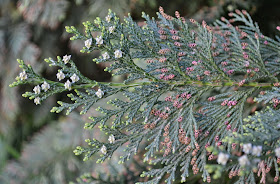11 April 2014 OS Map
174: Newbury & Wantage SU8736-8734
2 hours
These two quiet
neighbouring villages just west of Wantage are only a kilometre apart and
easily covered by a short walk, with plenty of botanical interest, particularly
spring bulbs. The area has several old
records of wild tulip Tulipa sylvestris
and this was one of our main targets, having failed to find it in many other
locations where it has been recorded. We
were, indeed, beginning to think that it had vanished from all its former
haunts. Although not a true native, but
a southern European plant, it had long been established, possibly introduced by
the Romans or early Crusaders.
We started at the church in
Childrey. There was a colony of creeping
comfrey Symphytum grandiflorum under
the wall of the house opposite the churchyard, while the churchyard walls had
wall-rue Asplenium ruta-muraria and
pellitory-of-the-wall Parietaria judaica.
Creeping comfrey, Childrey
The grassland of
the churchyard itself had a splendid display of primroses Primula vulgaris and polyanthus Primula
x polyantha cv., attracting bee-flies and spring butterflies like
orange-tip, peacock and small tortoiseshell.
Primroses, Childrey
churchyard
Other introduced
bulbs included:
Garden
grape-hyacinth Muscari armeniacum,
distinct from our native Muscari
neglectum in its bright blue flowers (not dark blue to black) - although
garden centres often sell it as neglectum
(even more confused by the fact that the illustrations in Blamey, Fitter &
Fitter's "Wild Flowers" appear to be the wrong way round!);
Garden grape-hyacinth
Several daffodil cultivars such as
'Vulcan', 'Carol Lombard', 'White Lady', 'Kilworth' and 'Aircastle';
'White Lady'
Yellow and blue anemones Anemone ranunculoides and A. apennina.
Yellow anemone
Blue anemone
Other low plants
included slender speedwell Veronica
filiformis, cowslip Primula veris
and cuckooflower Cardamine pratensis.
Slender speedwell
The churchyard has
a number of tall Lawson cypress Chamaecyparis
lawsoniana which were just now colourful in their new flowers (red male,
and white female towards the tips of each spray). There was also a tall conical form 'Lutea'
with golden foliage.
Lawson cypress flowers
Lawson cypress (right)
& form Lutea (left)
Along the lane
going west towards Sparsholt, just before leaving Childrey, was some shining
cranesbill Geranium lucidum. Approaching Sparsholt opposite a house on the
left is a low marshy area with marsh marigold Caltha palustris and a copse with large patches of few-flowered garlic
Allium paradoxum. At the roadside was also a daffodil escape or
throw-out, 'Actaea', attracting the hoverfly Melanostoma scalare.
Few-flowered garlic
'Actaea' daffodil and
hoverfly Melanostoma scalare
At the end of this
lane, instead of turning right into the village, we turned left, going south
from Sparsholt. Half way along on the
right hand side was another solitary house and opposite it the bank had an
extensive patch of creeping comfrey, perhaps the largest we have ever come
across, extending into the copse above.
There were also large clumps of spurge laurel Daphne laureola, more patches of few-flowered garlic, some cowslips
and a clump of gladdon Iris foetidissima.
Creeping comfrey well
naturalised at Sparsholt
Spurge laurel, Sparsholt
At the crossroads
at the top of this lane the banks had more cowslips and lesser celandine Ficaria verna, but the real joy was
reserved for two colonies of wild tulip, one behind a fence on the right-hand
side, under some trees, the other along the open banks of the lane going left. There were going on for a hundred of the
yellow acute-petalled blooms altogether, but many more clumps of the
distinctive narrow grey-green leaves, so unlike the usual garden tulip. At this site, at least, the plant is doing
well. The bulbs are easily available for
purchase and we resolved straight away that we must buy some for our garden and
help ensure the survival of this splendid species. The Berkshire Flora mentions that many of the
wild tulip populations are sterile, but it is apparent that it must here be
managing to spread by seed, with two patches separated by a road. Whether this plant has been here centuries or
merely decades, it is impossible to tell.
Beneath the trees
Beside the road
A flash of gold
We then returned
jubilantly to the main part of Sparsholt village. The verge outside the churchyard was very
flowery, with yet more few-flowered garlic (which has an extensive hold around
the village), leaves of winter aconite, and more grape-hyacinth, this time the
dark-flowered native species, though no doubt here it is a garden escape.
Roadside carpet of
few-flowered garlic in Sparsholt
Grape-hyacinth
In the churchyard
itself there were again many primroses (with a clump of the umbelled variety),
mixed with cowslips, both sweet and common dog-violets Viola odorata and V.
riviniana, and field woodrush or Good Friday grass Luzula campestris. The only
plants on the church walls, however, were hart's-tongue Asplenium scolopendrium and greater celandine Chelidonium majus. On the
way to the Star Inn in the centre of the little village, for an excellent
lunch, we passed some spotted medick Medicago
arabica. At lunch we had soup with a
pesto of "wild garlic" and there could be little doubt of local
provenance! Perhaps finding a use for
the few-flowered garlic has helped ensure its survival.
Umbelled primrose,
Sparsholt churchyard



















No comments:
Post a Comment